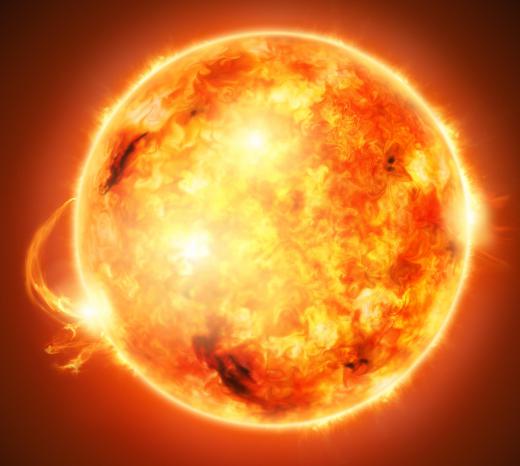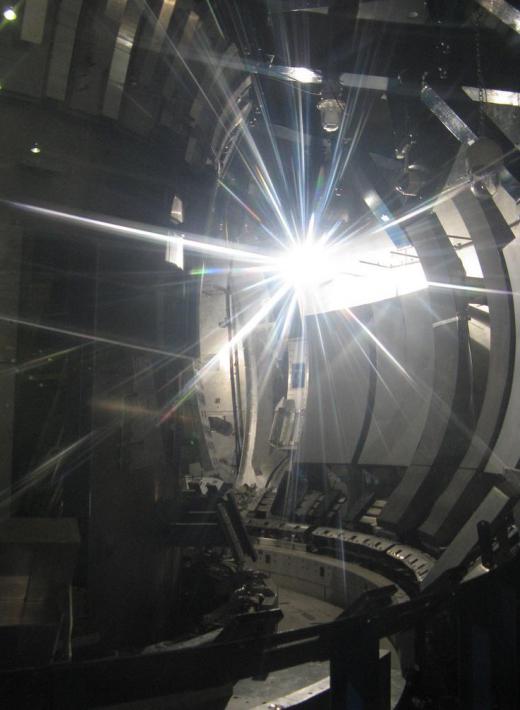How Much Energy does the Sun Generate?
 Michael Anissimov
Michael Anissimov
Our Sun pumps about 386 billion million gigawatts into space, mostly in the form of electromagnetic radiation. By comparison, a large nuclear reactor generates about 1 gigawatt, and global energy consumption is a few thousand gigawatts. This energy output is typical for a star in the same class as our Sun.
Prior to the discovery of nuclear power, scientists envisioned the Sun as a ball of combusting matter. Because the Sun is so large, it could have theoretically consisted of conventional matter in a state of combustion -- but this burning could only last for a few dozen thousand years before the matter would have been completely depleted. Today we know that the Sun is fueled by nuclear energy.

The Sun's total energy output is slowly declining as it fuses together the nuclei of light elements and is left with non-fusible, heavier matter. Eventually this power output will decline so fast that the explosive energy of fusion is outpaced by the attractive pull of gravity, and the star will collapse. The heat generated from the collapse will cause the diameter of our Sun to expand to the size of Mars' orbit.

Only a minuscule portion of the Sun's energy falls on our Earth, yet this energy is responsible for running almost every living thing on the planet. It is widely supposed that as our civilization progresses, it will begin to discard dirty fossil fuels in favor of the cleaner and ultimately more plentiful solar energy.
The energy output of the Sun is not entirely constant. Solar flares and sunspot activity cause small variations in the amount of light sent outwards. It has been speculated that a period of lowered sunspot activity in the 17th century, the Maunder minimum, may have been responsible for a period of declined heat in Europe called the Little Ice Age. It has also been theorized that the Sun's energy output has increased by about 40% since the formation of the solar system.
AS FEATURED ON:
AS FEATURED ON:












Discussion Comments
I always forget just how much the earth is affected by the sun. Without the sun we obviously wouldn't have any light or warmth, but the sun affects more than that. For example, plants need sunlight to grow, and plants filter the air to make it breathable! Without the sun, we wouldn't have any oxygen.
It is kind of scary how even a very small change in the sun's energy can affect the earth. As the article said, lowered sunspot activity caused serious climate change! Just imagine what would happen if there was a large increase or decrease in the sun's activity.
@starrynight - That's an interesting way to look at, but sounds practical to me. It's funny they don't make any movies about the sun collapsing though; I guess it's not as dramatic as an asteroid hitting the earth or something like that.
Anyway, I'm actually amazed at how much energy the sun gives off. I actually think that one day we'll be running a lot more things on solar power. I know in some countries like India, a lot of areas skipped installing power lines for electricity and started using solar power for their homes.
I think it's only a matter of time before we seriously pursue solar power as an energy solution.
It's interesting that in the course of generating all this energy, the sun is causing its own immediate collapse. However, from what I understand, this is the normal life cycle of a star, and takes thousands of years for the star to complete.
I always think of this when people talk about various apocalyptic end of the world scenarios. Really, we already know how the world is going to end, barring something unforeseen: our sun is going to collapse! Life on earth can't exist without the sun, so it will be the end of the world!
response for anon28117:
Watts are a per time unit so 1 watt = 1 joule per second.
Joule is an energy unit. Watt is an energy per second unit.
Re BTUs/sq ft/hour etc...
Use SI units?-easier to calculate then!
What is the time period for the "386 billion million gigawatts" figure, every minute? Second? Hour? Day? Year?
How much is "a minuscule portion of the Sun's energy falls on our Earth"?
How much of that minuscule amount are we currently using through passive/active solar and wind?
How many BTU,s per square foot/per hour will the sun generate on a Spring Day?
Post your comments